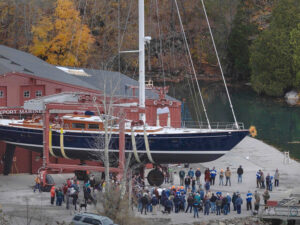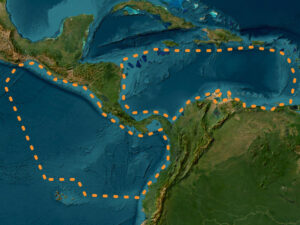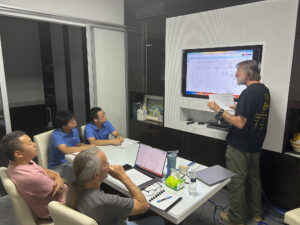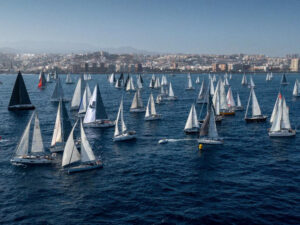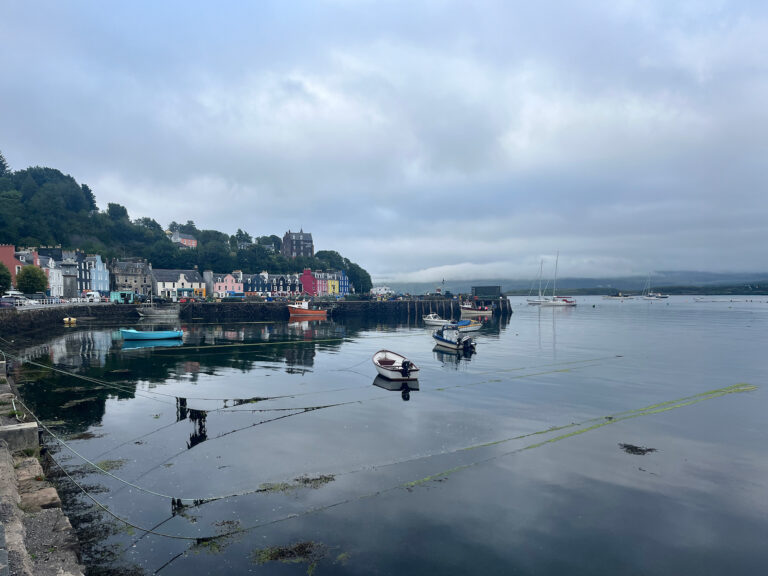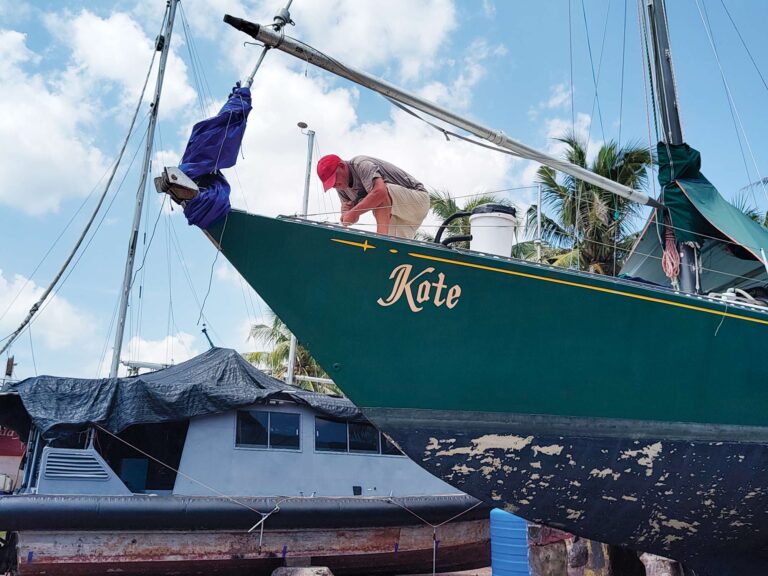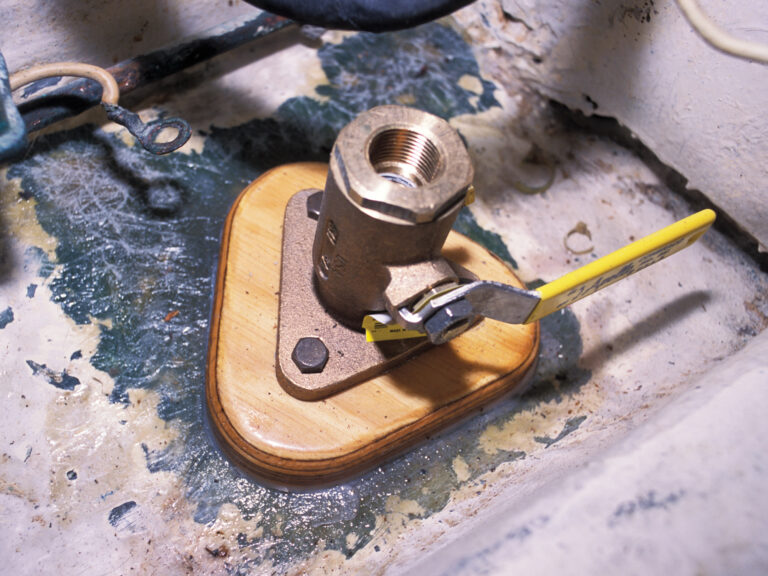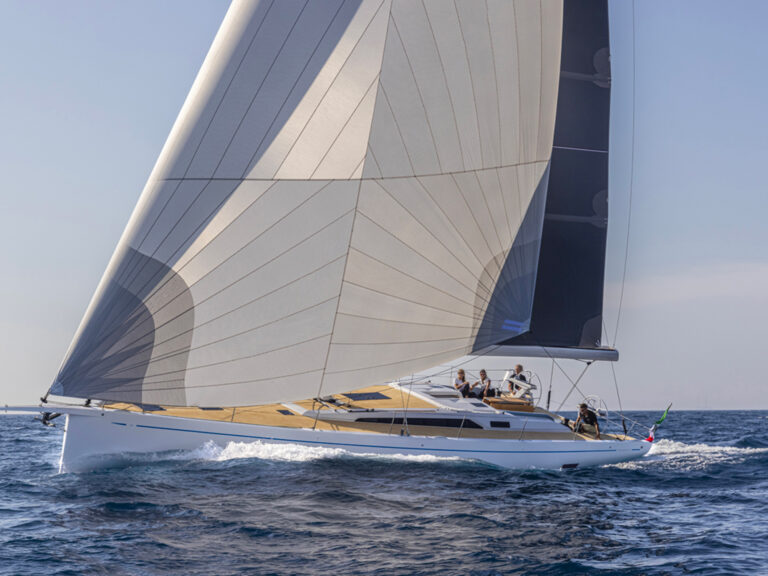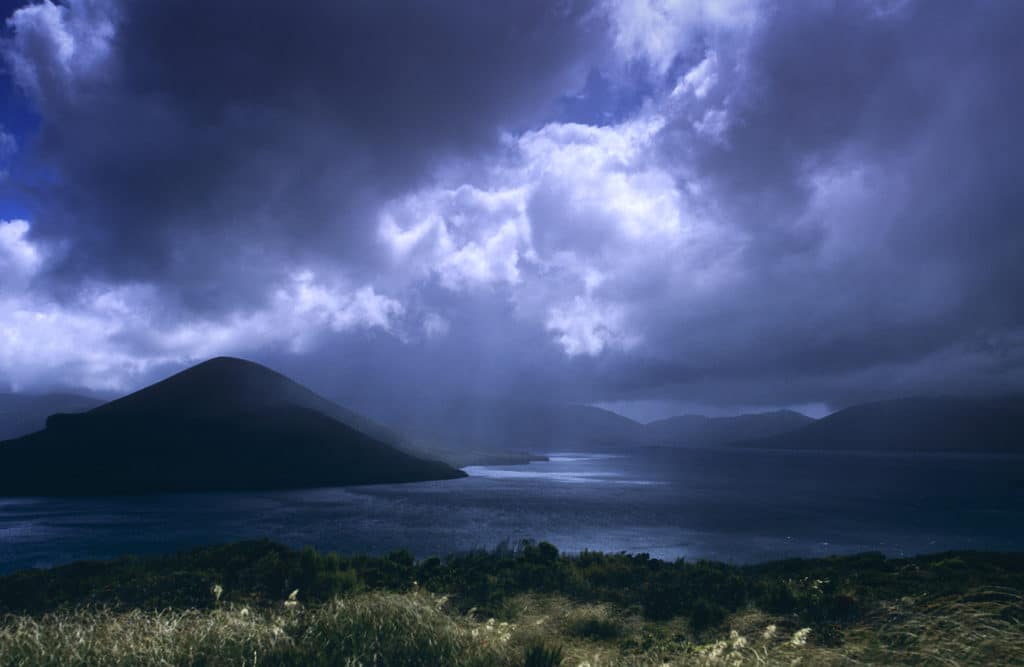
It hadn’t occurred to me that we might not find the Auckland Islands. With mountaintops that tower more than 2,000 feet, the tightly packed group of eight islands comprising the New Zealand subantarctic archipelago is more than 10 miles wide. They should have been visible from a great distance, particularly to Kicki’s sharp eyes. But for the last 48 hours, my wife had been as seasick as I’d ever seen her. And my degree of misery wasn’t far better. After sitting drenched in the cockpit, hand-steering Wanderer III for the better part of two days, covering some 220 nautical miles toward a sliver of narrow, wild coast, I craved some vital support.
“I need your eyes!” I called into the black hole of a cabin, sliding open the hatch. I was mumbling at this point: “Can’t see it. Our location is all iffy. If this continues, we might have to turn back.”
I could make out nothing in the gale-driven mist. The log that trailed from our stern put us about 10 miles off Auckland Island, the largest in the group. Had we oversailed our landfall? In order not to run into it, we had been heaved to for an afternoon and a night. Now in daylight, we inched forward once more, under storm jib and reefed main, hard on the wind. It had been wet ever since we headed south from Stewart Island’s unsung South Cape, the planet’s southernmost save for Cape Horn.
It was the ocean shelf between the cape and our position that was Kicki’s undoing. Battered by Force 8 winds, the nearly 10,000-foot-deep Southern Ocean jumps this 650-foot shallow hurdle with attitude. We never saw the Snares Islands, which lay along our route, though we must have been close. We never saw any of the brightly lit squid boats that frequent these waters, either. The bad weather hid them. But immediately around us, life teemed. This shelf is a huge dinner plate: Wherever I looked, I saw feeding birds — but nothing else as Wanderer crept south-southwest.
It took ages for Kicki, dressed in her foul-weather gear, to appear in my wet realm of doubt: Where were we? Where was Auckland Island’s north coast? I didn’t want to overshoot the island and end up along its western side. There, a history rich in disasters lingered. Many ships have gone down along that inescapable 20-mile crescent of 2,000-foot-high cliffs stretching north to south. It is an unsurvivable wall if one is driven into it by westerly storms. Facing 40-knot winds, I had time and reason enough to form misgivings about the wisdom — and luck — required for finding this goddamn place.
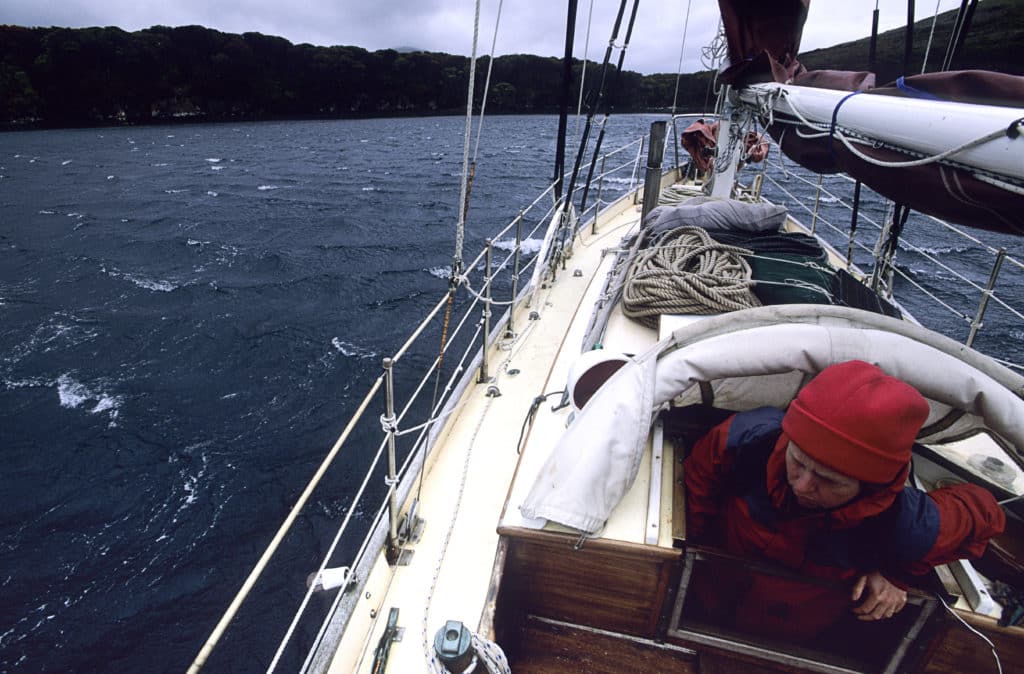
At last, Kicki crawled over the washboard for only the second time on the trip, passing from a black hole into a wet hole: our cockpit. And she was more determined to reach our landfall than I was.
“No way. That’s just not on,” Kicki said, picking up on my already forgotten mumblings. At first I didn’t grasp her meaning; I was a bit surprised at how sharp she seemed, considering her mal de mer. “Back to Stewart Island without getting to the Aucklands at all? I’m not suffering for that.”
Then she took up her position at the mast, her small frame harnessed safely to the boat but rising and falling with the waves.
The incubation period for my Auckland Islands dreams had been longer than for any other destination — well over a dozen years. Once the islands appeared on my mental horizon, they remained there, in sight yet out of reach. Our first attempt at reaching them, in 1995, ended in the vicinity of the Snares Islands in the face of a southerly gale. The storm and the already advanced summer made us turn around. Attempt number two saw Wanderer and us stuck high and dry in a New Zealand boatyard that proved to have considerable suction; Smith’s Reef, we called it. We had a Department of Conservation-approved visitor permit in our pockets, but no vessel in the water. The hard times on the hard carried on, so we never got going.
And now, this third approach? It got underway by surprise. By pure chance I had mentioned the Auckland Islands to my uncle Bruno, the only Cape Horner in our family, a man rich in seafaring lore. Bruno was then far into his 80s.
“Where to? The Auckland Islands?” He made sure he had heard right. “Then you must know of the Erlangen Clearing.”
Of course I did. Mainly that some ironwood trees felled on the Auckland Islands stood at the core of an incredible tale.
“Well, those trees … ” said Bruno, as he launched into a gripping story that held me spellbound an entire afternoon.
In the maritime world, this extraordinary account of the imaginative escape of the 6,100-ton German merchant ship Erlangen, at the onset of World War II, is without equal. I never knew that Bruno’s rich life had been shaped by it, one of the greatest sea stories of all time. Even Hollywood thought it worth a film, The Sea Chase, with John Wayne. But Bruno’s detailed narration was the better thriller.

Erlangen’s early-morning arrival at the Auckland Islands, with no chart in a vicious storm and with nowhere else to go, must have been as iffy as our approach. On August 31, 1939, a day before the outbreak of World War II, Capt. Alfred Grams idled off Perpendicular Point, in the south of the group. The most important information he’d been able to extract from his pilot book was that nobody lived in the Aucklands. The day before, with the world still at peace but holding its breath, the captain had shared breakfast and German beer with the New Zealand harbor pilot in Dunedin. With a handful of Germans and 50 Chinese as crew, Erlangen had left the port nearly empty, without much food and with just 150 tons of coal — enough for a maximum of five days steaming. The New Zealanders were confident that Erlangen would be their first war prize. With so little coal, she couldn’t reach anywhere the Brits or French were not. Escape was impossible. She would soon be impounded.
Grams and his crew had cleared for a coal port in Australia and were watched from ashore, steaming north. Then, under cover of darkness, with the portholes blackened and ship lights switched off, they swung around and headed south. Soon Erlangen became a maritime riddle. She hadn’t been seen anywhere. Despite her reduced range due to her limited supply of coal, she had simply vanished.
Public imagination ran wild and searches were launched. But nobody thought that the boat would be hidden 12 miles deep within the Auckland Islands’ natural Carnley Harbour. Erlangen was sitting in mud, staging for her much more daring escape. Grams hadn’t found much food ashore; instead he discovered the equivalent of gold in the form of a hardwood called rata. Three tons of rata equaled one ton of coal. To reach the neutral safety of Chile under the steam of her engines, Erlangen needed to carry at least 400 tons. Wielding self-made saws, Grams’ men cut what they could, creating the Erlangen Clearing. The steam winches worked for weeks. Meanwhile, thanks to some of the crew’s expertise in big-ship sailing, they produced two masts and a bulging square rig. Protected by terrible weather, Grams counted the tons of wood that piled up each day, and on his luck.
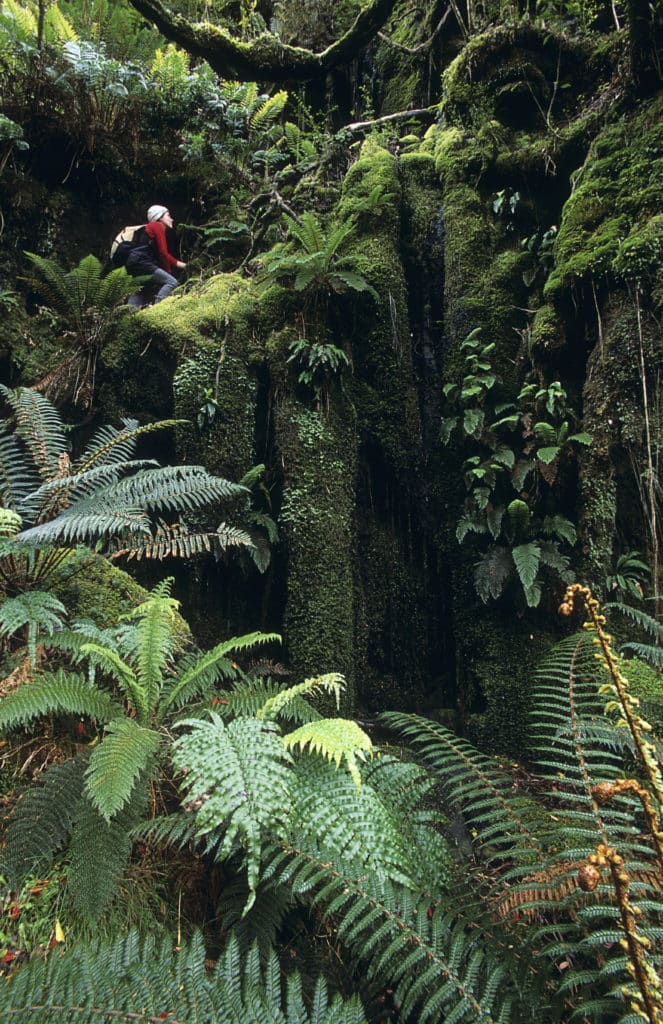
Carnley Harbour was a perfect hiding place for Erlangen. The New Zealanders who searched the Auckland Islands never found her, and the crew eventually escaped by burning rata and skillfully employing their sails. In a widely acclaimed feat of seamanship, they made it across the Southern Ocean to the safety of Chile’s Puerto Montt.
At that time, my uncle Bruno was 19 years young and living in Valparaiso, Chile. He had crewed aboard the four-masted bark Priwall, the fastest-ever tall ship to double Cape Horn, from 50 south around to 50 south, east to west. Afterward he found himself idling away on Priwall at anchor in Valparaiso. It was then that Erlangen crossed his path, in need of crew to continue her legendary voyage. Asked if he would muscle coal for Erlangen on a secretive trip back around Cape Horn and into the Atlantic, he signed on for the second dramatic chapter of the escape, of which all that remains is a tale and those stumps I hoped to find.
“They cleared the trees. Their stumps must still be there,” he hinted, “probably overgrown.”
Ever since my afternoon with Uncle Bruno, I had wanted to find those stumps and sit on them — in a dripping, windy place where yellow-eyed penguins incubate their eggs under trees and sea lions mate in the forest.
After a year spent at Stewart Island, we decided it was time to try for the Aucklands again. In compliance with our permit, we had Wanderer’s underwater hull checked for an invasive algae. It’s a Department of Conservation biosecurity measure to prevent the algae from reaching farther south. With no rats on board, and no mice, cats nor pigs, we were cleared for departure. On our last night in Stewart Island’s Thule Bay, morepork owls called from the three islands with beautiful names — Hope, Faith and Charity — that shelter the anchorage.
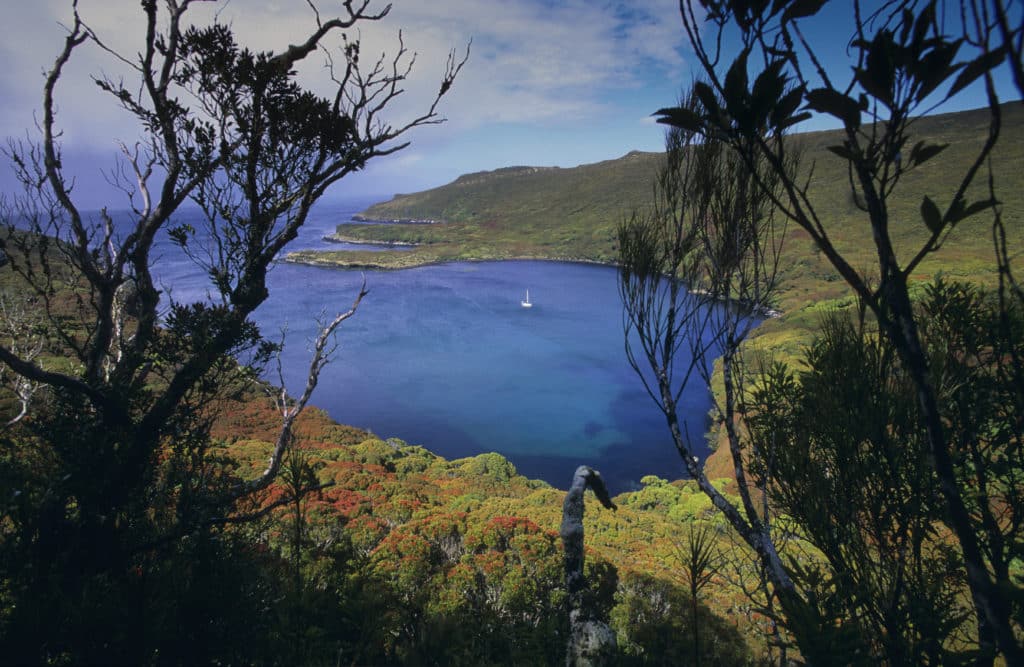
A little hope, faith and charity (along with the shelter those islands provided) would have been very welcome on our voyage south. The sea proved hard going; water filled the cockpit time and time again. To the limits of the horizon, nothing solid could be seen. Perched at the mast, Kicki suddenly turned her neck, her right arm raised.
“There. See it?” She waved at something beyond my visual reach. An outline.
“Where?” I asked. “There?” Propped up by her conviction, I suddenly saw it too — or thought I did. Briefly I hovered between doubt and delight, though I never burst into relief. There was nothing there: What we’d spotted were yearned-for contours, born of wishful minds.
One hour disappeared, then another. How thick was the mist? I wondered. How far could my vision penetrate it? We must be close to the island, I thought. But in waters like these, how close would be too close? I glimpsed the minutest fragments of a waterlogged source of light and convinced myself it was the sun. Chased by clouds, even the slight fragments of light dissolved in the eastern sky.
We could only hope our luck would hold and at some point bring us true sunlight, as well as a decent horizon on which to get a fix on our location. To entice it, I monitored the feeblest appearances of light hiding behind the wall of gray. On the rare occasion the sun tentatively showed itself, its rim was frayed by clouds; the horizon could only be guessed at, and it jumped about, a creation of my imagination when I lifted the sextant and attempted the first sun-sight of the trip.
Again and again the instrument got drenched. To dry the mirrors, I repeatedly handed it to Kicki, who had gone below. I tried perhaps a dozen times, and then one sight finally felt right. I rushed below to work it out. Our perpendicular line of position was quickly drawn on the chart; it cut directly through the island’s north shore. We were somewhere on that line. The single sight confirmed that we were northwest of the island. I trusted it. I had to. There was no other option.
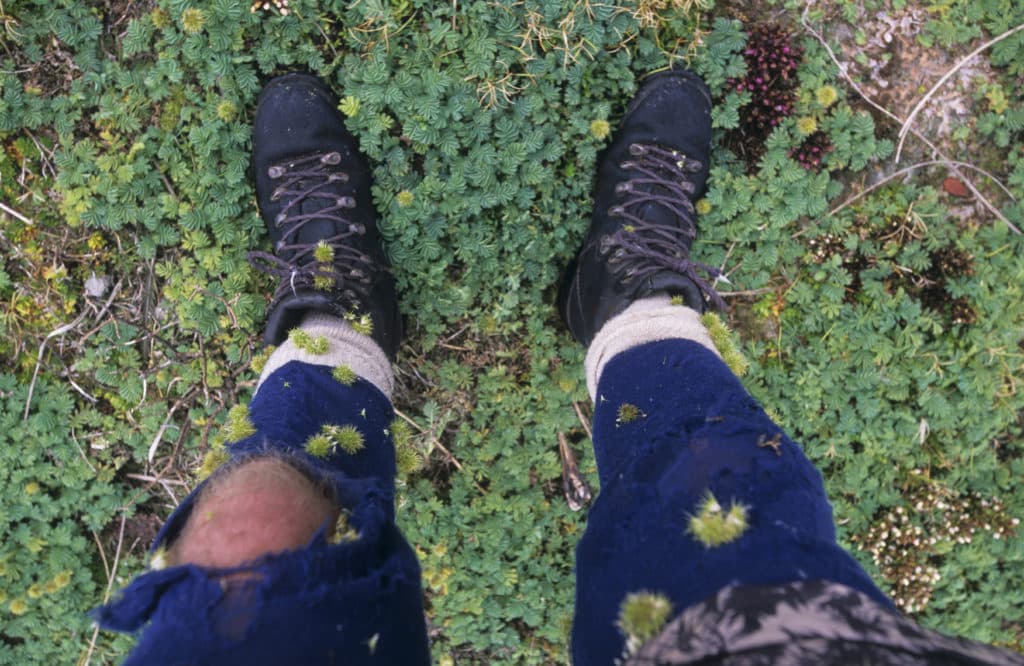
Even though we still could not see land, we turned Wanderer and eased the sheets. It was oh so easy to ride the waves with the wind from astern. Within only half an hour, the Aucklands’ north cape presented itself out of the eternal haze. Only 3 miles away, we saw it at last.
Once we sighted land, we closed in on Enderby Island, only to be greeted by an abrupt increase in wind upon entering the 4-mile-deep Port Ross. It was a battle of many hours, under storm jib and deeply reefed main, to tack toward Erebus Cove. There the 45-pound CQR wouldn’t hold, and we had to switch to our heavier chain. But as if the blow had simply wanted to remind us of where we were, it died away. Only then did we notice groups of pintado petrels bathing innocently near the shore, next to blooming rata trees, as if on a summer vacation.
The next day’s arrival was the slowest in my history of sailing. We woke late, ate pancakes and slept again. There was no rush now that we’d arrived. We had two months to discover impenetrable dwarf forests. In other woods on the islands, songbirds accompanied our every step, hopping close by from branch to branch. Various albatrosses — shy, sooty, royal and wandering — bred on grassy plateaus. Along the precipitous west coast cliffs, waterfalls blew upward, defying gravity so their waters never reached the sea. We found penguins deep in the woods, along with the love nests of “hookers,” as the local sea lions are called. We watched our ensign, the Dannebrog, or Danish national flag, flog itself to half size thanks to two severe storms.
Eventually we sailed deeper into the chronically overcast Carnley Harbour, all the way into its north arm, where we anchored in 13 feet over mud, as Erlangen had long before us.
Surrounded by a wooded shoreline, we couldn’t readily see where we might find the Erlangen Clearing. Days passed, in fact, before we discovered it. It was absolutely not, as I’d imagined, in the open grassy space at the shallow bay’s end. No, we looked there. Then one afternoon Kicki approached me from behind and bent over my left shoulder with a big smile. “Guess what?” she asked. She had found the remnants of the rata trees.
I followed her lead, and then I recognized tree stumps scattered across a hillside that I found difficult to imagine as a clearing. The impenetrability of the second-growth forest made a mockery of the name. Everything was overgrown. In the Erlangen Clearing it was easier to crawl than to walk. And it was easier yet to sit and just take it in.
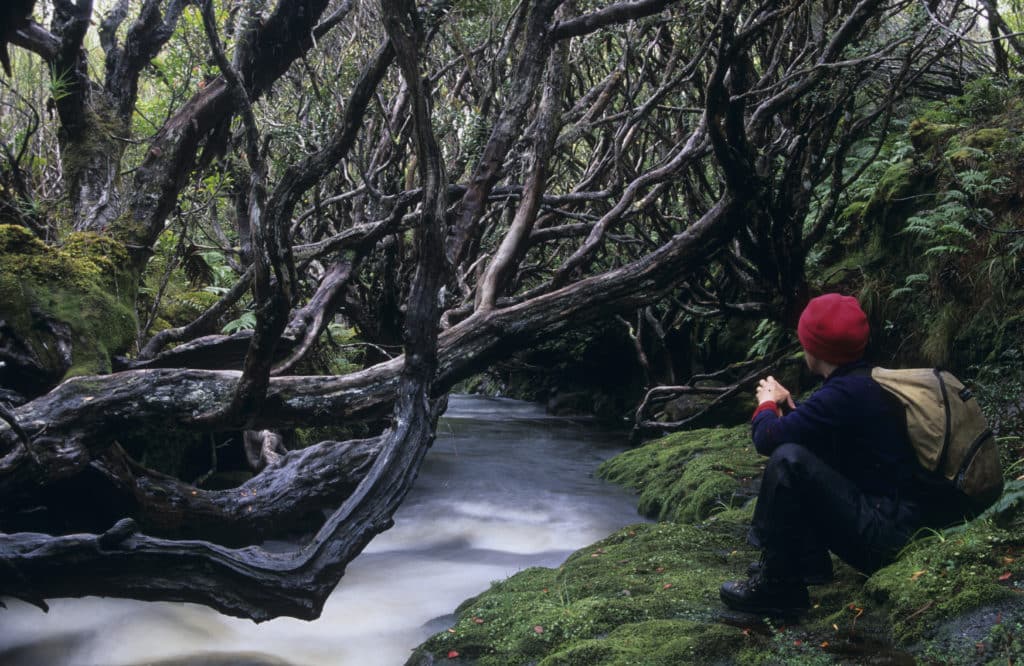
In one of the world’s most southern forests, I chose a weathered stump whose perfectly leveled cut strangely contrasted with the chaotic growth around it. I found other leveled tree stumps closer to the shore. From each one I took bearings: Across the northern arm of Carnley Harbour, over Wanderer III and Figure of Eight Island, toward the Musgrave Peninsula. From each stump, Figure of Eight Island blocked the direct view to the entrance of this out-of-the-way bay.
I understood what these various perspectives told me, why the Kiwis searching for Erlangen in the early days of war missed her entirely.
I crawled out of the nearly impassable clearing and back to the beach. There the wind celebrated our discovery with atypical nonattendance. It was so still I could hear the swooping of circling sooty shearwater flocks. In front of me the water was a mirror-smooth zoo of paddling, diving and flying neighbors. Wherever my head turned, something moved and made sounds, except for the broken rata branches that had worked themselves into the shoreline.
I picked some up, carried them home and stoked the woodstove on Wanderer. There they crackled — in as strange a sound, I thought, as the Mandarin of 50 Chinese sailors who once warmed themselves in this same distant place.

Kicki and Thies Matzen and Wanderer III are currently in the Falkland Islands.

